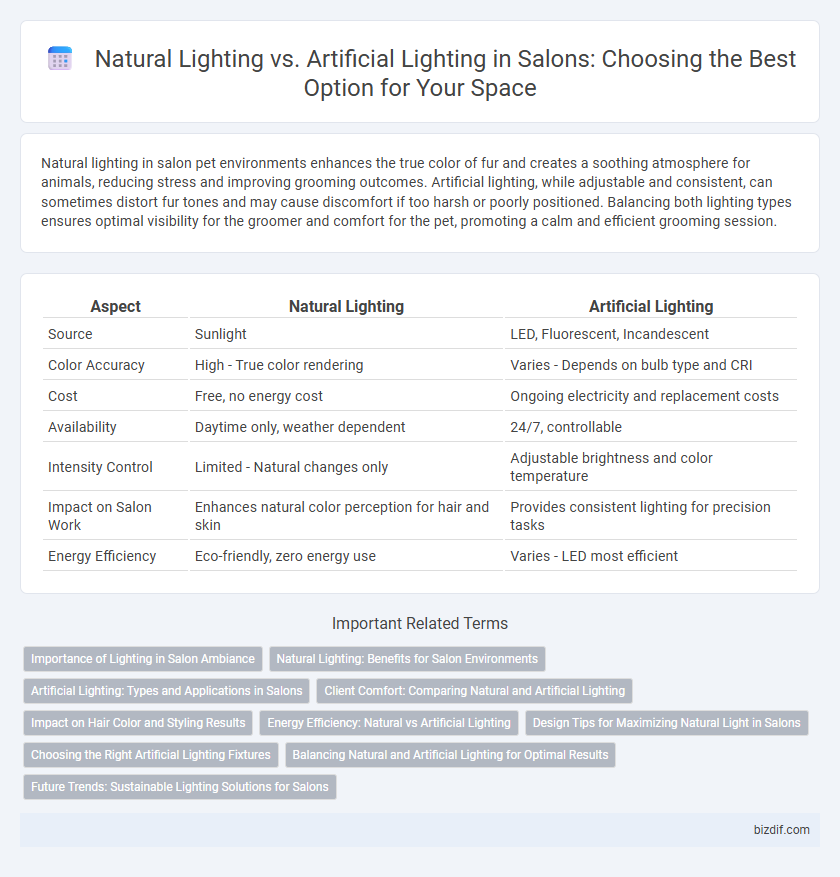Natural lighting in salon pet environments enhances the true color of fur and creates a soothing atmosphere for animals, reducing stress and improving grooming outcomes. Artificial lighting, while adjustable and consistent, can sometimes distort fur tones and may cause discomfort if too harsh or poorly positioned. Balancing both lighting types ensures optimal visibility for the groomer and comfort for the pet, promoting a calm and efficient grooming session.
Table of Comparison
| Aspect | Natural Lighting | Artificial Lighting |
|---|---|---|
| Source | Sunlight | LED, Fluorescent, Incandescent |
| Color Accuracy | High - True color rendering | Varies - Depends on bulb type and CRI |
| Cost | Free, no energy cost | Ongoing electricity and replacement costs |
| Availability | Daytime only, weather dependent | 24/7, controllable |
| Intensity Control | Limited - Natural changes only | Adjustable brightness and color temperature |
| Impact on Salon Work | Enhances natural color perception for hair and skin | Provides consistent lighting for precision tasks |
| Energy Efficiency | Eco-friendly, zero energy use | Varies - LED most efficient |
Importance of Lighting in Salon Ambiance
Natural lighting enhances salon ambiance by providing true color accuracy and a welcoming atmosphere, crucial for precise hair and makeup application. Artificial lighting offers consistent illumination regardless of time or weather, enabling salons to maintain uniform brightness and highlight details effectively. Optimal lighting balance supports client comfort, stylist efficiency, and overall aesthetic appeal, directly impacting service quality and customer satisfaction.
Natural Lighting: Benefits for Salon Environments
Natural lighting in salon environments enhances color accuracy for hair treatments and makeup applications, promoting more precise and satisfying results. Exposure to natural daylight improves client mood and comfort, creating a welcoming and relaxing atmosphere that encourages repeat visits. Energy efficiency also increases as natural light reduces dependence on artificial lighting, lowering operational costs and supporting eco-friendly business practices.
Artificial Lighting: Types and Applications in Salons
Artificial lighting in salons includes LED, fluorescent, and incandescent lights, each offering unique color temperatures and intensities tailored for specific tasks. LED lighting is increasingly popular for its energy efficiency, longevity, and ability to provide consistent, bright illumination ideal for detailed work such as hair coloring and makeup application. Fluorescent lights are often used for ambient lighting due to their broad coverage, while incandescent bulbs add warmth to the salon environment for a more comfortable client experience.
Client Comfort: Comparing Natural and Artificial Lighting
Natural lighting in salons enhances client comfort by providing a soft, even illumination that reduces eye strain and creates a relaxing atmosphere. Artificial lighting, often adjustable in intensity and color temperature, allows salons to maintain consistent visibility regardless of time or weather but may sometimes cause glare or harsh shadows. Balancing both lighting types optimizes client comfort, improving overall satisfaction and the perception of service quality.
Impact on Hair Color and Styling Results
Natural lighting enhances the true vibrancy and undertones of hair color, ensuring precise color matching and more accurate assessment during styling. Artificial lighting, depending on its warmth or coolness, can distort hair color perception, leading to potential mismatches or styling inconsistencies. Salons benefit from combining natural and high-quality artificial lighting to achieve the best results in both color application and final styling appearance.
Energy Efficiency: Natural vs Artificial Lighting
Natural lighting in salons reduces energy consumption significantly by utilizing sunlight, which is a free and renewable resource. Artificial lighting, especially LED technology, offers controlled illumination with lower energy use compared to traditional bulbs but still relies on electricity. Optimizing salon design to maximize natural light while supplementing with energy-efficient artificial options can enhance overall energy efficiency and reduce operational costs.
Design Tips for Maximizing Natural Light in Salons
Maximizing natural light in salons enhances client comfort and creates a vibrant atmosphere, essential for accurate color treatments and overall ambiance. Employ large, unobstructed windows with sheer curtains or blinds to diffuse sunlight evenly while reducing glare. Incorporate reflective surfaces such as mirrors and light-colored walls to amplify daylight, and position styling stations near windows to optimize natural illumination for precision work.
Choosing the Right Artificial Lighting Fixtures
Selecting the right artificial lighting fixtures in a salon is essential for achieving accurate color representation and enhancing client comfort. LED lights with a color temperature between 5000K and 6500K closely mimic natural daylight, providing true-to-tone illumination ideal for hair coloring and makeup application. Adjustable fixtures with dimming capabilities allow stylists to customize brightness levels, ensuring optimal visibility without causing glare or eye strain.
Balancing Natural and Artificial Lighting for Optimal Results
Balancing natural and artificial lighting in a salon enhances visibility and creates a comfortable atmosphere for both clients and stylists. Utilizing large windows and skylights allows abundant natural light to highlight true hair and skin tones, while adjustable artificial lighting fills shadows and ensures consistent illumination throughout the day. Combining these lighting sources optimizes color accuracy and reduces eye strain, leading to improved service quality and client satisfaction.
Future Trends: Sustainable Lighting Solutions for Salons
Future trends in salon lighting emphasize sustainable solutions that combine natural lighting with energy-efficient artificial options. Innovations such as LED technology with adjustable color temperatures and daylight-mimicking bulbs reduce energy consumption and enhance client comfort. Integrating skylights and large windows maximizes natural light, creating eco-friendly, visually appealing salon environments.
Natural Lighting vs Artificial Lighting Infographic

 bizdif.com
bizdif.com